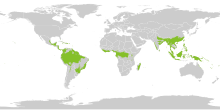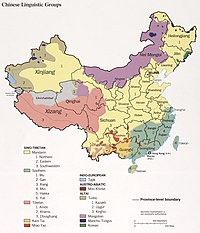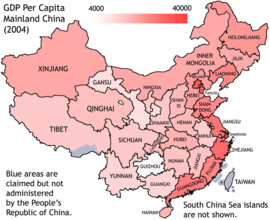Northern China (Chinese: 中国北方 or 中国北部; lit. 'China's North') and Southern China (Chinese: 中国南方 or 中国南部; lit. 'China's South')[note 1] are two approximate regions that display certain differences in terms of their geography, demographics, economy, and culture.
Extent
[edit]
The Qinling–Daba Mountains serve as the transition zone between northern and southern China. They approximately coincide with the 0 degree Celsius isotherm in January, the 800 millimetres (31 in) isohyet, and the 2,000-hour sunshine duration contour.[1] The Huai River basin serves a similar role,[2][3] and the course of the Huaihe has been used to set different policies to the north and the south.[4]
History
[edit]
Historically, populations migrated from the north to the south, especially its coastal areas and along major rivers.[5][6]
After the fall of the Han dynasty, The Southern and Northern Dynasties (420–589) ruled their respective part of China before re-uniting under the Tang dynasty.[7]
During the Qing dynasty, regional differences and identification in China fostered the growth of regional stereotypes. Such stereotypes often appeared in historic chronicles and gazetteers and were based on geographic circumstances, historical and literary associations (e.g. people from Shandong, were considered upright and honest) and Chinese cosmology (as the south was associated with the fire element, Southerners were considered hot-tempered).[8] These differences were reflected in Qing dynasty policies, such as the prohibition on local officials to serve their home areas, as well as conduct of personal and commercial relations.[8] In 1730, the Kangxi Emperor made the observation in the Tingxun Geyan (庭訓格言):[8][9]
The people of the North are strong; they must not copy the fancy diets of the Southerners, who are physically frail, live in a different environment, and have different stomachs and bowels.
— the Kangxi Emperor, Tingxun Geyan (《庭訓格言》)
During the Republican period, Lu Xun, a major Chinese writer, wrote:[10]
According to my observation, Northerners are sincere and honest; Southerners are skilled and quick-minded. These are their respective virtues. Yet sincerity and honesty lead to stupidity, whereas skillfulness and quick-mindedness lead to duplicity.
— Lu Xun, Complete works of Lu Xun (《魯迅全集》), pp. 493–495.
Today
[edit]

Climate
[edit]Northern regions of China have long winters that are cold and dry, often below freezing, and long summers that are hot and humid.[12] Transitional periods are short. The ecology is simple and not resilient to droughts.[6]
Many southern regions are subtropical and green year round. The winters are short. They often experience typhoons and the East Asian monsoon in the summer.[13] The ecology is complex, and floods are more common.[6]
Diet and produce
[edit]The northern regions are easier to cultivate.[6] Hardy crops such as corn, sorghum, soybeans, and wheat are grown, and one to two crops are produced each year.[8] The growing season lasts four to six months. Wheat-based food such as bread, dumplings, and noodles are more common.[14][12]
Cultivation of the southern regions began later in history.[6] Warm temperatures and abundant rainfall help produce rice and tropical fruits.[12] Two to three crops can be grown each year, and the growing season lasts nine to twelve months.[8] Rice-based food is more common.[14][12]
Language and people
[edit]Jones Lamprey, a British army surgeon in 1868,[15] writes that northerners have lighter skin tones than southerners, although the shade can change greatly from season to season depending on an individual's exposure to sunlight when performing manual labor outdoors.[16] Northerners are often taller than southerners.[17]
Variants of Mandarin are widely spoken in northern regions and often with a rhotic accent.[6][16] Ethnic groups are comparatively more diverse in southern regions.[8] Rhotic accent is usually absent from the Mandarin spoken there. Different dialects are less mutually intelligible, and additional languages such as Cantonese or Hokkien are spoken.[16] Patrilineage organizations are larger and more integrated in rural southern regions, possibly due to merges and competition for territory.[6]
A series of studies on regional differences in China suggest that people from places that grow wheat have different social styles and thought styles from those in rice-growing regions.[18][19][20] Respondents from northern China are found to be more individualistic, think more analytically, and more open to strangers. Those from the southern regions are more likely to think holistically, interdependent, and draw a larger distinction between friends and strangers. The difference was attributed to the growing of rice, which often requires the sharing labor and managing shared irrigation infrastructure.[19][21][22]
Transportation
[edit]Traveling between places tends to be easier in northern regions where the terrain is more even.[6]
Economy
[edit]As China modernized, the north initially developed faster due to planned economic policies, Soviet aid, and its concentration of construction and resource extraction industries. After market reforms, however, the south took the lead due to manufacturing and eventually high-tech industries, as well as continued internal migration into the region.[5]
Health
[edit]A research showed that life expectancy was slightly higher in Southern China compared to Northern China. In 2018, it was 76.66 years for North and 77.35 for South.[23] According to the data from a survey in 2011, people in Southern China were 10.51% less likely to be obese and overweight compared to the North.[24]
See also
[edit]- Cultural regions in China
- List of regions of China
- Nanquan (Southern Fist)
- Global North and Global South
- North–South divide in Taiwan
Notes
[edit]- ^ Also referred to in China as simply the north (Chinese: 北方; pinyin: Běifāng) and the south (Chinese: 南方; pinyin: Nánfāng).
- ^ The map shows the distribution of linguistic groups according to historical majority ethnic groups, which may have shifted due to prolonged internal migration and assimilation.
References
[edit]Citations
[edit]- ^ Lan, Xincan; Li, Wuyang; Tang, Jiale; Shakoor, Abdul; Zhao, Fang; Fan, Jiabin (28 April 2022). "Spatiotemporal variation of climate of different flanks and elevations of the Qinling–Daba mountains in China during 1969–2018". Scientific Reports. 12 (1). doi:10.1038/s41598-022-10819-3. ISSN 2045-2322. PMC 9050673. PMID 35484392.
- ^ Yin, Yixing; Chen, Haishan; Wang, Guojie; Xu, Wucheng; Wang, Shenmin; Yu, Wenjun (1 May 2021). "Characteristics of the precipitation concentration and their relationship with the precipitation structure: A case study in the Huai River basin, China". Atmospheric Research. 253: 105484. doi:10.1016/j.atmosres.2021.105484. ISSN 0169-8095.
- ^ Xia, Jun; Zhang, Yongyong; Zhao, Changsen; Bunn, Stuart E. (August 2014). "Bioindicator Assessment Framework of River Ecosystem Health and the Detection of Factors Influencing the Health of the Huai River Basin, China". Journal of Hydrologic Engineering. 19 (8). doi:10.1061/(ASCE)HE.1943-5584.0000989. hdl:10072/66836. ISSN 1084-0699.
- ^ "China's Huai River Policy and Population Migration: A U-Shaped Relationship – Nova Science Publishers". Retrieved 2 September 2024.
- ^ a b "Weekend Long Read: Why China's North-South Economic Gap Keeps Getting Bigger - Caixin Global". www.caixinglobal.com. Retrieved 27 August 2024.
- ^ a b c d e f g h Xuefeng, He (7 March 2022). Northern and Southern China: Regional Differences in Rural Areas. Routledge. ISBN 978-1-000-40262-9.
- ^ Lewis, Mark Edward (30 April 2011). China Between Empires: The Northern and Southern Dynasties. Harvard University Press. ISBN 978-0-674-06035-7.
- ^ a b c d e f Smith, Richard Joseph (1994). China's cultural heritage: the Qing dynasty, 1644–1912 (2 ed.). Westview Press. ISBN 978-0-8133-1347-4.
- ^ Hanson, Marta E. (July 2007). "Jesuits and Medicine in the Kangxi Court (1662–1722)" (PDF). Pacific Rim Report (43). San Francisco: Center for the Pacific Rim, University of San Francisco: 7, 10. Archived from the original (PDF) on 19 March 2012. Retrieved 12 July 2011.
- ^ Young, Lung-Chang (Summer 1988). "Regional Stereotypes in China". Chinese Studies in History. 21 (4): 32–57. doi:10.2753/csh0009-4633210432. Archived from the original on 29 January 2013.
- ^ Source: United States Central Intelligence Agency, 1990.
- ^ a b c d "Regions of Chinese food-styles/flavors of cooking". regional cuisines. Archived from the original on 16 April 2009.
- ^ Zhu, Hua (1 March 2017). "The Tropical Forests of Southern China and Conservation of Biodiversity". The Botanical Review. 83 (1): 87–105. Bibcode:2017BotRv..83...87Z. doi:10.1007/s12229-017-9177-2. ISSN 1874-9372. S2CID 29536766.
- ^ a b Eberhard, Wolfram (December 1965). "Chinese Regional Stereotypes". Asian Survey. 5 (12). University of California Press: 596–608. doi:10.2307/2642652. JSTOR 2642652.
- ^ "Jones Lamprey | Historical Photographs of China". hpcbristol.net. Retrieved 17 November 2023.
- ^ a b c Lamprey, J. (1868). "A Contribution to the Ethnology of the Chinese". Transactions of the Ethnological Society of London. 6: 101–108. doi:10.2307/3014248. ISSN 1368-0366. JSTOR 3014248.
- ^ Lu, Guoguang; Yang, Zhihui; Zhang, Yan; Lu, Shengxu; Gong, Siyuan; Li, Tingting; Shen, Yijie; Zhang, Sihan; Zhuang, Hanya (2022). "Geographic latitude and human height - Statistical analysis and case studies from China". Arabian Journal of Geosciences. 15 (335). Bibcode:2022ArJG...15..335L. doi:10.1007/s12517-021-09335-x.
- ^ Talhelm, Thomas; Dong, Xiawei (27 February 2024). "People quasi-randomly assigned to farm rice are more collectivistic than people assigned to farm wheat". Nature Communications. 15 (1): 1782. Bibcode:2024NatCo..15.1782T. doi:10.1038/s41467-024-44770-w. ISSN 2041-1723. PMC 10899190. PMID 38413584.
- ^ a b Talhelm, T.; Zhang, X.; Oishi, S.; Shimin, C.; Duan, D.; Lan, X.; Kitayama, S. (9 May 2014). "Large-Scale Psychological Differences Within China Explained by Rice Versus Wheat Agriculture". Science. 344 (6184): 603–608. Bibcode:2014Sci...344..603T. doi:10.1126/science.1246850. ISSN 0036-8075. PMID 24812395.
- ^ Talhelm, Thomas; Zhang, Xuemin; Oishi, Shigehiro (6 April 2018). "Moving chairs in Starbucks: Observational studies find rice-wheat cultural differences in daily life in China". Science Advances. 4 (4): eaap8469. Bibcode:2018SciA....4.8469T. doi:10.1126/sciadv.aap8469. ISSN 2375-2548. PMC 5916507. PMID 29707634.
- ^ Talhelm, Thomas; Oishi, Shigehiro (2018). "How Rice Farming Shaped Culture in Southern China". In Uskul, Ayse (ed.). Socio-Economic Environment and Human Psychology: Social, Ecological, and Cultural Perspectives. New York, NY: Oxford University Press. pp. 53–76. doi:10.1093/oso/9780190492908.003.0003. ISBN 9780190492908. LCCN 2017046499. SSRN 3199657.
- ^ Bray, Francesca (1994). The Rice Economies: Technology and Development in Asian Societies. University of California Press. ISBN 978-0-520-08620-3.
- ^ Mengqi Wang; Yi Huangyi (18 September 2020). "Why Residents in Southern China Live Longer Than Those in Northern China?" (PDF). Semantic Scholar. Retrieved 14 October 2024.
Table 1, Page number 2
- ^ Daisheng Tang; Tao Bu (2020). "Differences in Overweight and Obesity between the North and South of China". Research gate. Retrieved 14 October 2024.
Page number 789, Paragraph 2
Further reading
[edit]- Brues, Alice Mossie (1977). People and Races. Macmillan series in physical anthropology. New York, NY: Macmillan. ISBN 978-0-02-315670-0.
- Du, Ruofu; Yuan, Yida; Hwang, Juliana; Mountain, Joanna; Cavalli-Sforza, L. Luca (1992). "Chinese Surnames and the Genetic Differences between North and South China". Journal of Chinese Linguistics Monograph Series (5): 1–93. ISSN 2409-2878. JSTOR 23825835.
- Ebrey, Patricia Buckley; Liu, Kwang-chang. (1999). The Cambridge Illustrated History of China. Cambridge University Press.
- Morgan, Stephen L. (2000). "Richer and Taller: Stature and Living Standards in China, 1979-1995". The China Journal (44): 1–39. doi:10.2307/2667475. ISSN 1324-9347. JSTOR 2667475. PMID 18411497.
- Muensterberger, Warner (1951). "Orality and Dependence: Characteristics of Southern Chinese." In Psychoanalysis and the Social Sciences, (3), ed. Geza Roheim (New York: International Universities Press).